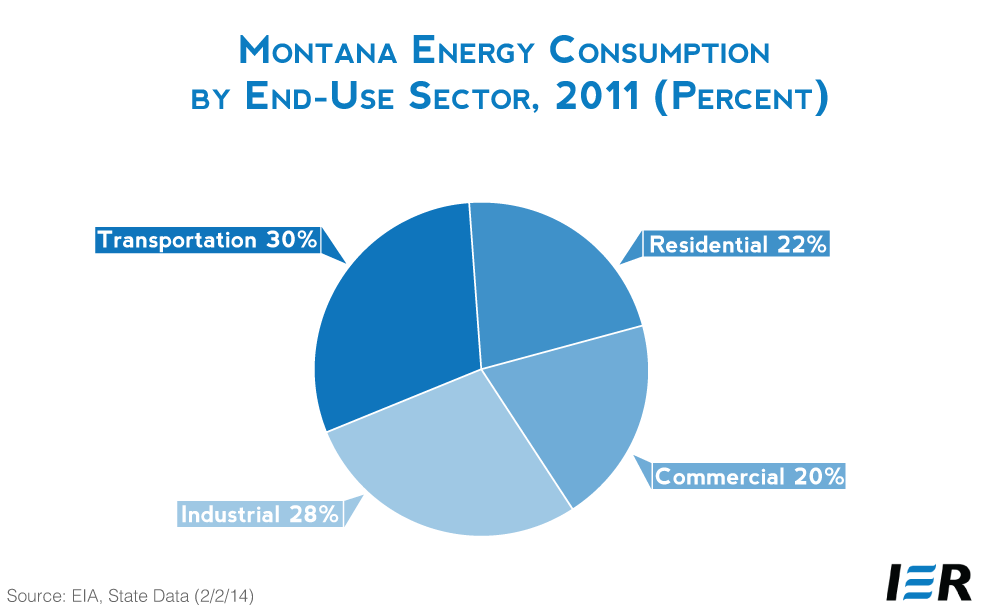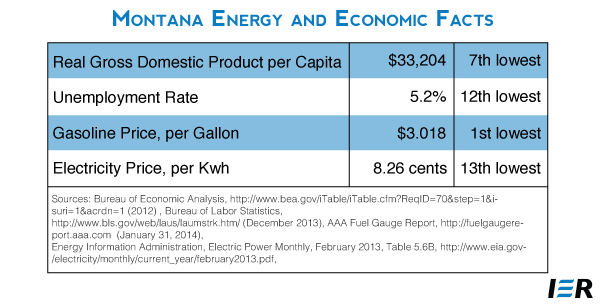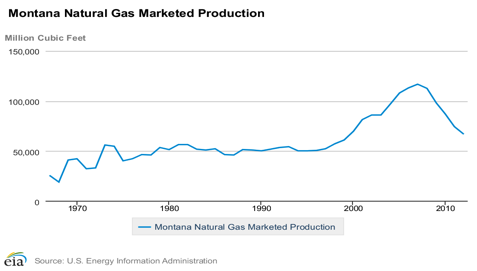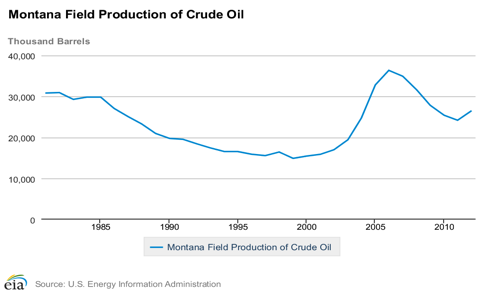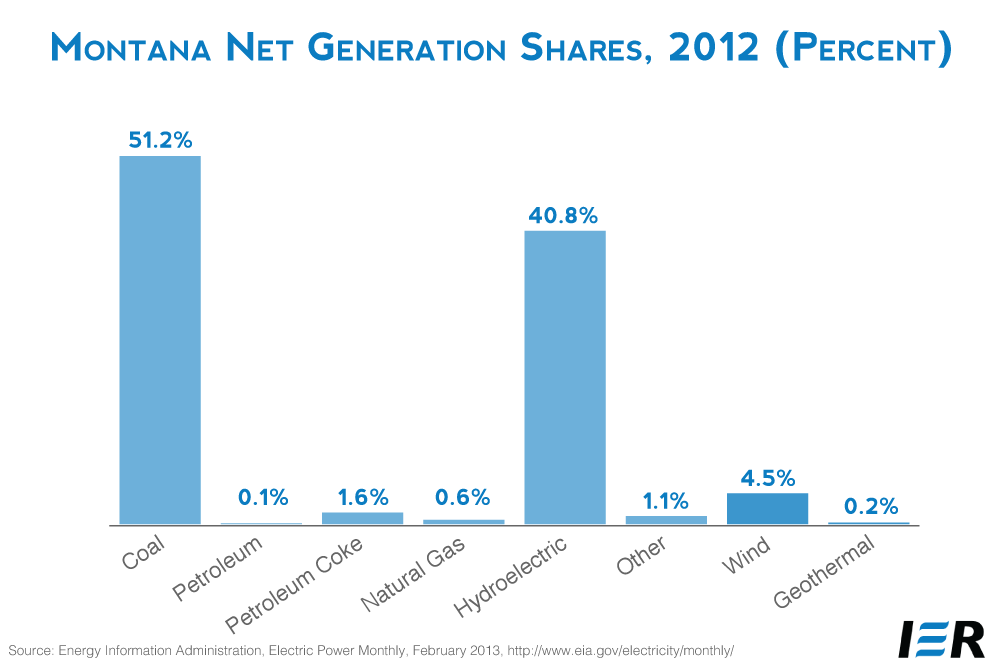Montana is the third least-densely populated state with fewer than 10 residents per square mile in much of the state’s eastern third. At over 93 million acres, it is about 138 times as large as Rhode Island, the nation’s smallest state. The state supplies fossil fuels and renewable energy to the nation. Montana contains more than one-fourth of the nation’s estimated recoverable coal reserves. Its eastern basins contain large deposits of crude oil and natural gas. The Missouri basin contains hydroelectric energy resources and the state’s vast plains contain some of the best wind resources in the United States.
Agriculture is the state’s largest industry followed by tourism due to Glacier and Yellowstone National Parks. Other major industries include mining and oil and gas production. The state’s economy is energy-intensive and per capita energy consumption is relatively high. The transportation and industrial sectors lead energy consumption, accounting for 58 percent of total energy use in the state.
Source: Energy Information Administration, http://www.eia.gov/state/data.cfm?sid=WY#ConsumptionExpenditures
Montana’s State Rankings
- In 2011, Montana ranked 17th among the states in total energy production, producing 1,105 trillion Btu of energy.
- In October, 2013, Montana ranked 12th in oil production, producing 2,379 thousand barrels.
- In 2012, Montana ranked 20th in natural gas production, producing 66,954 million cubic feet.
- In 2012, Montana ranked 8th in coal production, producing 36,694 thousand short tons.
- In October 2013, it ranked 41st in electricity production, producing1,890 thousand megawatt hours of electricity.
- In 2012, Montana had the 13th lowest average electricity retail price in the United States.
- In 2011, Montana ranked 14th in total energy consumed per capita, consuming 398 million Btu per person.
- In 2010, Montana ranked 42nd in carbon dioxide emissions, emitting 34.9 million metric tons of carbon dioxide.
Coal
Montana has the nation’s largest estimated recoverable coal reserves and one-fourth of the nation’s demonstrated coal reserve base. Montana ranks eighth in coal production among the states producing from a half dozen mines. The state produces almost 4 percent of the nation’s coal, primarily from several large surface mines in the Powder River Basin in southeastern Montana.
Around one-fourth of the coal mined in Montana is consumed within the state for electricity generation. The Rosebud mine, the state’s second largest surface mine, provides coal via conveyor belt to the Colstrip generating plant, the largest coal plant within the state. About two-fifths of Montana’s coal is sent by rail to other states. The rest of Montana’s coal production is shipped by rail to western Canada for export, primarily to Asia.
U.S. coal demand and production has been declining due to competition from low cost natural gas and onerous regulations from the Environmental Protection Agency for coal-fired power plants. Between 2011 and 2012, Montana’s coal production declined by 13 percent. Several recent proposals to build new coal-fired generating plants in Montana have been dropped due to federal air-quality regulations. One of Montana’s older coal-fired electricity generating stations is being mothballed. EPA expects about 100 megawatts of Montana’s coal and petroleum coke plants to be prematurely retired in 2015 due to EPA’s Mercury and Air Toxics Rule (Utility MACT) and its Cross State Air Pollution Rule (CSAPR).
To help the fledging coal industry, several Montana coal mine development projects are being proposed to supply the export market. The state is also involved with a test of carbon sequestration in a formation near the Canadian border.
Natural Gas
Montana produces a small amount (0.3 percent) of the nation’s natural gas and consumes most of it in-state. About three-fourths of Montana’s natural gas wells are in the north central part of the state, near the Canadian border. Natural gas is also produced in the Williston Basin and near the Wyoming border. Production from natural gas and coal-bed methane wells in Montana has been declining due to producers investing in new oil wells rather than natural gas wells.
Source: Energy Information Administration, http://www.eia.gov/dnav/ng/hist/n9050mt2a.htm
Montana is crossed by natural gas pipelines from Canada and Wyoming, and most natural gas entering the state continues on to North Dakota and Midwestern markets. Almost one-third of net U.S. natural gas imports from Canada enter the country through Montana.
Montana has more underground natural gas storage capacity than any other state in the Mountain West due to the Baker/Cedar Creek field in the Williston Basin, the nation’s largest single underground storage facility. Other storage facilities serve pipelines coming south from Canada and connecting into Wyoming.
Over 55 percent of Montana’s households use natural gas as their primary energy source for home heating. Natural gas consumption in Montana is fairly evenly distributed among the industrial, residential, and commercial sectors, and the state’s per capita usage is at the national median.
Petroleum
Montana accounts for 1 percent of U.S. crude oil production and about the same percentage of U.S. proven reserves. Most of Montana’s production is concentrated near the North Dakota border. Montana’s Elm Coulee field was initially the most prolific in the Williston Basin, which spreads from eastern Montana into North Dakota and Canada. But, attention shifted to North Dakota due to the thicker resource underlying the Bakken Shale formation, resulting in Montana’s oil production declining from its high in 2006. Recently, however, leasing has begun to increase in Montana, spreading through several northeastern counties. Leasing is also occurring in the northwest in the Alberta Basin Bakken formation.
Source: Energy Information Administration, http://www.eia.gov/dnav/pet/hist/LeafHandler.ashx?n=PET&s=MCRFPMT1&f=A
New oil production in Montana has been constrained by lack of pipeline capacity. There are several pipelines that move Montana crude oil to refineries in Wyoming, Utah, Colorado, and the Midwest and a number of new pipeline projects are under development, mainly to move crude oil to the Gulf Coast’s major refining centers. Due to constrained pipeline capacity, crude oil transport by rail has increased considerably.
Montana has four operating refineries with a capacity of 188,600 barrels per day. Three refineries are located in the Billings region and one at Great Falls. They receive crude oil largely from Canada and Wyoming and produce a range of refined products, including motor gasoline, diesel fuel, propane, and asphalt. Pipelines and railroads are used to ship crude oil into and refined products out of the refineries. Montana has no ethanol refineries although several have been proposed. Ethanol is brought in from neighboring states and blended at terminals connected to refineries.
About three-fifths of the petroleum products consumed in the state are used in the transportation sector, and another one-fourth in the industrial sector. Montana’s petroleum consumption is low, but it is among the top 10 states in per capita consumption.
During the winter months, Montana requires oxygenated motor gasoline in the Missoula area to meet federal air quality standards. It allows the use of conventional motor gasoline in the rest of the state.
Electricity
Coal-fired power plants produced over 50 percent of the state’s electricity in 2012; hydroelectric power produced over 40 percent; and wind power produced over 4 percent of the state’s generation. Natural gas and petroleum generate only minor amounts of the state’s electricity generation.
Montana is a major hydroelectric power producer. Its mountainous terrain along the Continental Divide contains fast-running rivers, and the eastern two-thirds of the state is drained by the Missouri River and its tributaries. Six of the state’s 10 largest generating plants are hydroelectric facilities. The state contains a number of old hydroelectric dams, some of which are federally run. Hydroelectric generating capacity is being expanded within the state.
Montana has some of the best commercial wind resources in the nation. The state has several wind farms in the center of the state, and more are being planned. A wind project is proposed for the largest U.S. Superfund site that surrounds the former Anaconda copper smelter in western Montana. Development of new wind projects in Montana depends partly on demand for renewable energy from California and other states with high requirements for renewable energy in their Renewable Portfolio Standards.
Montana is looking toward developing geothermal energy. The state has geothermal resources in the mountainous southwest. But, so far it has not been used for electricity generation instead being used for aquaculture, greenhouses, spas, resorts, and, early in the 20th century, for district heating. Advanced geothermal technology is being explored to access the energy in the hot water co-produced with crude oil in Montana wells.
Source: Energy Information Administration, Electric Power Monthly, February 2013, http://www.eia.gov/electricity/monthly/
In 1997, Montana deregulated its electricity system and later re-regulated some aspects of its electricity generation industry because of rising electricity costs. But, more than two-thirds of its net electricity generation still comes from independent power producers. The commercial and residential sectors each consume a little more than one-third of the electricity used in Montana, and the industrial sector consumes the rest.
Montana consumes about one-half of the electricity generated in the state and exports the remainder to other western states via high-voltage transmission lines. Because Montana’s current transmission lines are congested, new transmission capacity is needed to expand electricity sales. Several transmission projects are being developed to increase capacity from Montana to states to the west and southwest and to expand an intertie with Canada. Most of Montana is part of the Western Interconnection grid serving western states and Canadian provinces. A portion of eastern Montana is connected to the eastern U.S. grid. A large transmission and pumped storage project has been proposed that would bring wind power to consumers in the Midwest.
Montana has a Renewable Resource Standard that requires retail electricity suppliers to obtain 15 percent of the electricity they sell in-state from renewable energy sources by 2015. Power must come from renewable facilities that began operation after 2004. Eligible technologies include wind, solar, geothermal, biomass, and certain wastes, as well as small hydroelectric facilities. The standard also requires electricity suppliers to buy a certain amount of power from smaller community-based renewable energy projects.
Due to its relatively low electricity prices, 21 percent of the state’s households use electricity as their primary source for home heating.
Montana Regulatory Environment
Below are some facts about Montana’s regulatory environment that are likely to affect the cost of energy or the cost of using energy. Although affordable energy is a vital component of a healthy economy, regulations frequently increase energy costs.
Montana does not provide a cap on greenhouse gas emissions. But, Montana is an observer of the Western Climate Initiative (WCI), a regional agreement designed to target greenhouse gas reductions. The central component of this agreement was to eventually enact a cap-and-trade scheme to reduce greenhouse gas emissions 15 percent below 2005 levels by 2020. As an observer of the WCI, Montana is not bound to agreements made by WCI members. In 2011, all of the states except California left the WCI leaving only California and the Canadian provinces British Columbia, Manitoba, Ontario, and Quebec as full members.
While not providing a cap on greenhouse gas emissions, Montana does have a de facto ban on new coal fired power plants. Passed in 2007, House Bill 25 prohibits regulatory pre-approval of new coal plants that do not sequester 50 percent of their carbon dioxide. This is a de facto prohibition on pre-approval of all new coal-fired power plants because carbon capture sequestration technology to sequester the coal is not yet commercially available.
Enacted in April 2005 as part of the Montana Renewable Power Production and Rural Economic Development Act, Montana’s renewable portfolio standard requires public utilities and competitive electricity suppliers serving 50 or more customers to obtain a percentage of their retail electricity sales from eligible renewable resources. For compliance years 2010 through 2014, the percentage is 10 percent, and, for compliance year 2015 and for each year thereafter, the percentage is 15 percent.
Eligible renewable resources include wind; solar; geothermal; existing hydroelectric projects (10 megawatts or less); certain new hydroelectric projects (up to 15 megawatts installed at an existing reservoir or on an existing irrigation system that did not have hydroelectric generation as of April 16, 2009); landfill or farm-based methane gas; wastewater-treatment gas; low-emission, non-toxic biomass; and fuel cells where hydrogen is produced with renewable fuels. Facilities using these resources must begin operation after January 1, 2005, and must either be located in Montana or located in another state and be delivering electricity into Montana.
Two bills in 2013 expanded the state’s renewable portfolio standard to include additional types of projects. SB 325 allows wood pieces that have been treated with chemical preservatives, such as creosote, pentachlorophenol, or copper-chrome arsenic, and that are used at a facility that has a nameplate capacity of 5 megawatts or less. SB 45 allows expansions to existing hydroelectric projects that result in increased generation capacity. Construction on the expansion must commence on or after October 1, 2013.
Montana’s Mandatory Utility Green Power Option requires regulated electric utilities to offer customers the option of purchasing electricity generated by certified, environmentally-preferred resources that include, but are not limited to, wind, solar, geothermal and biomass. NorthWestern Energy implemented a green-power program in June 2003.
Montana requires new residential and commercial buildings to be certified as energy-efficient. Residential and commercial buildings must comply with the 2009 International Energy Conservation Code (IECC) with state amendments. The IECC developed by the International Code Council is a model code that mandates certain energy efficiency standards. The energy codes are reviewed on a three-year cycle corresponding to the adoption of new versions of the International Code Conference (ICC) Uniform Codes.
In April 2009, the Montana legislature passed S.B. 49, creating energy efficiency standards for state-owned and state-leased buildings. Energy efficiency building standards apply to new construction and major renovation projects for state-owned buildings and new construction projects for state-leased buildings. The buildings must exceed the effective International Energy Conservation Code by 20 percent, if cost effective.
In July 1999, Montana enacted its net-metering law, which applies to all customers of investor-owned utilities that generate electricity using solar, wind, or hydropower and are no larger than 50 kilowatts in capacity. Net excess generation is credited to the customer’s next monthly bill. The customer may choose to start the net metering period at the beginning of January, April, July or October to match seasonal farming cycles.
Montana does not allow electric utilities or natural gas utilities to “decouple” revenue from the sale of electricity. Decoupling allows utilities to increase their revenue by selling less electricity and natural gas.
Montana requires the Missoula area to use oxygenated gasoline during the winter to meet federal air quality standards. Montana does not impose automobile fuel economy standards, which include attempts to regulate greenhouse gas emission from new vehicles.
Conclusion
Montana has fossil fuel and renewable resources that it supplies to the nation. Coal and hydroelectric power supply the majority of the state’s electricity. As a result, Montana has the13th lowest average retail electricity price in the nation, 16 percent less than the nation’s average electricity price in 2012.


